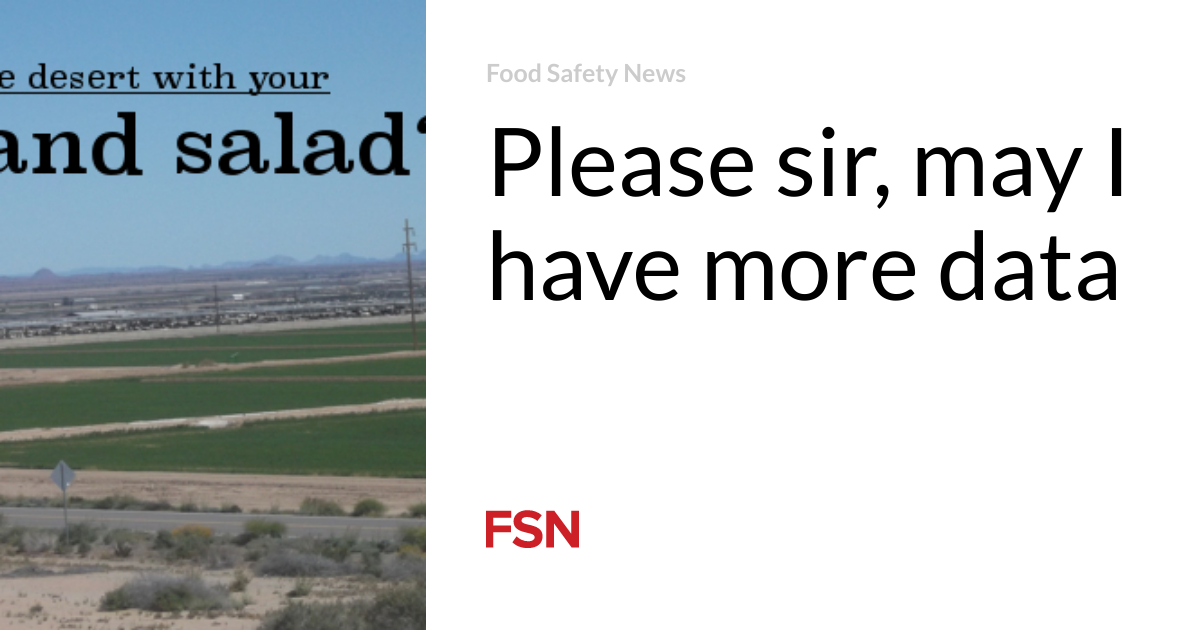Food
Please sir, may I have more details

– OPINION –
In response to the FDA’s “Southwest Agricultural Region Environmental Microbiology Study (2019 – 2024),” the National Cattlemen’s Beef Association wrote, “It is clear that more scientific data are needed…” (1). I disagree, there is an abundance of scientific data in the FDA study plus the significant amount of scientific data published over the last twenty years. These data indicate that the carriage of enteric zoonotic pathogens by cattle, pigs and poultry poses a risk to the environment and public health. More delays mean more illnesses, costs and deaths.
*https://www.fda.gov/food/environmental-studies/southwest-agricultural-region-environmental-microbiology-study-2019-2024
A recent review (2) also concluded that more research is needed. The authors wrote: “Although the information collected on proximity to livestock is concerning, the gaps in the data indicate that more studies need to be conducted to determine the relative contribution of different contamination mechanisms and to generate quantitative data to support analyzes of food safety risks related to leafy vegetables. Greens produced nearby cattle areas.” This and the Cattlemen’s statement is a classic example of instead of making a decision based on current information, “Let’s wait until we have more information, and more, …”.
There are CAFO drainage interventions (3), but they do not inhibit airborne vectors and other vectors (4). For more information, read the references in (4), copy the title to Google Scholar and view the 104 scientific articles that mention this title, or just the seven from this year.
The scientific publications show that fecally transmitted zoonoses contaminate the environment through manure, air, water and wildlife. In addition to the environment, FSIS wrote that it was unable to eliminate the pathogens entering swine farms. Science shows that the risk of enteric pathogens is similar in beef and poultry. For example, in beef processing, hide dust (dried feces) is a primary source of enteric pathogens (5). “Hide has been identified as the leading source of carcass contamination during livestock processing; therefore, it is critical to minimize the amount of Escherichia coli O157:H7 on bovine hides before slaughter.” If you walk through a beef slaughterhouse, look into a light or window and you will see an aerosol of dust. Washing hides before pulling them reduces that danger. There is still the danger of fecal contamination from rectal drop (which has improved over the last thirty years), Salmonella in the lymph nodes, and STEC coming from the oral cavity. The slaughter interventions are therefore comparable to hitting mosquitoes and ignoring their source, standing water.
Beef is the easy product to dissolve. The mechanical depilation and hair removal processes in poultry and pigs spread “non-visible fecal material” over the carcasses and to empty follicles where interventions cannot reach (6)(7).
Another article promoting the need for pre-harvest interventions: “The purpose of this article is to propose a more integrated and aggressive systems approach to food safety, rather than focusing on one segment of the industry, or on one approach as described or limited by one sector. set of regulations. We focus on the prevalence and control measures for Salmonella and Escherichia coli, specifically Shiga toxin-producing E. coli (STEC) in live cattle on the farm and in the final raw beef product at retail…’ and ‘Er little emphasis is placed on the conditions on the farm or feedlot where pathogen control can begin.” (8)
There are numerous studies and reviews on pre-harvest interventions. What is missing are incentives and regulations to create a level playing field. CDC, EPA, FDA, or FSIS cannot sample CAFOs to determine the source of zoonoses. APHIS can take samples, but can only act on animal pathogens and not human pathogens (remember the egg inspection?). Congress should take action to allow sampling of CAFOs, including beef, poultry, and swine production.
Tracing a zoonotic pathogen to its source will then enable regulatory action to prevent or reduce the threat to public health and protect operators carrying out interventions from economic disadvantage.
1. Livestock farmers dispute research showing that dust from feedlots can contaminate irrigation water
By Coral Beach on June 16, 2024
https://www.foodsafetynews.com/2024/06/cattlemen-contest-research-that-shows-dust-from-feedlots-can-contaminate-irrigation-water/
2. Dogan, OB, Flach, MG, Miller, MF and Brashears, MM, 2023. Understanding the potential contribution of livestock to chlorophyll outbreaks: an exploratory review of the literature and public health reports. Comprehensive Reviews in Nutrition Science and Food Safety, 22:3506-3530
3. Glaize, A., Young, M., Harden, L., Gutierrez-Rodriguez, E. and Thakur, S. 2021. The effect of vegetation barriers on reducing the transmission of Salmonella and Escherichia coli from animal activities to fresh Products . International J Food Microbiol. 347:109196.
4. Berry, ED, Wells, JE, Bono, JL, Woodbury, BL, Kalchayanand, N., Norman, KN, Suslow, TV, López-Velasco, G. and Millner, PD, 2015. Effect of proximity to livestock feedlot on Escherichia coli O157: H7 contamination of leafy vegetables and evaluation of the potential for airborne transmission. Appl. Environment. Microbiol. 81:1101-1110.
5. Arthur, TM, Bosilevac, JM, Brichta-Harhay, DM, Guerini, MN, Kalchayanand, N., Shackelford, SD, Wheeler, TL and Koohmaraie, M., 2007. Effects of transport and storage on prevalence, numbers , and diversity of Escherichia coli O157:H7 on hides and carcasses of beef cattle during processing. Journal of Food Protection, 70: 280-286.
7. Zeng, H., Rasschaert, G., De Zutter, L., Mattheus, W., & De Reu, K. (2021). Identification of the source of salmonella contamination of carcasses in a large pig slaughterhouse. Pathogens, 10:77.
7. Berrang, ME, Meinersmann, RJ, & Adams, ES 2018. Shredded sponge or paper as a cloacal plug to limit Campylobacter contamination of the broiler carcass during automated defeathering. Journal of Applied Poultry Research, 27:483-487.
8. Brashears, MM, Chaves BD. 2017, The Diversity of Beef Safety: A Global Reason to Strengthen Our Current Systems. Meat Science 132:59-71.
(To sign up for a free subscription to Food Safety News,Click here)













